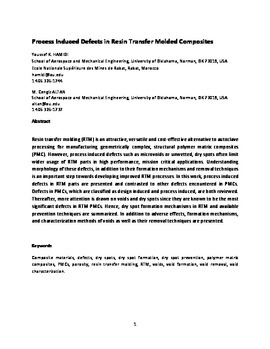| dc.description.abstract | Resin transfer molding (RTM) is an attractive, versatile and cost-effective alternative to autoclave processing for manufacturing geometrically complex, structural polymer matrix composites (PMC). However, process induced defects such as microvoids or unwetted, dry spots often limit wider usage of RTM parts in high performance, mission critical applications. Understanding morphology of these defects, in addition to their formation mechanisms and removal techniques is an important step towards developing improved RTM processes. In this work, process induced defects in RTM parts are presented and contrasted to other defects encountered in PMCs. Defects in PMCs, which are classified as design induced and process induced, are both reviewed. Thereafter, more attention is drawn on voids and dry spots since they are known to be the most significant defects in RTM PMCs. Hence, dry spot formation mechanisms in RTM and available prevention techniques are summarized. In addition to adverse effects, formation mechanisms, and characterization methods of voids as well as their removal techniques are presented. | en_US |
